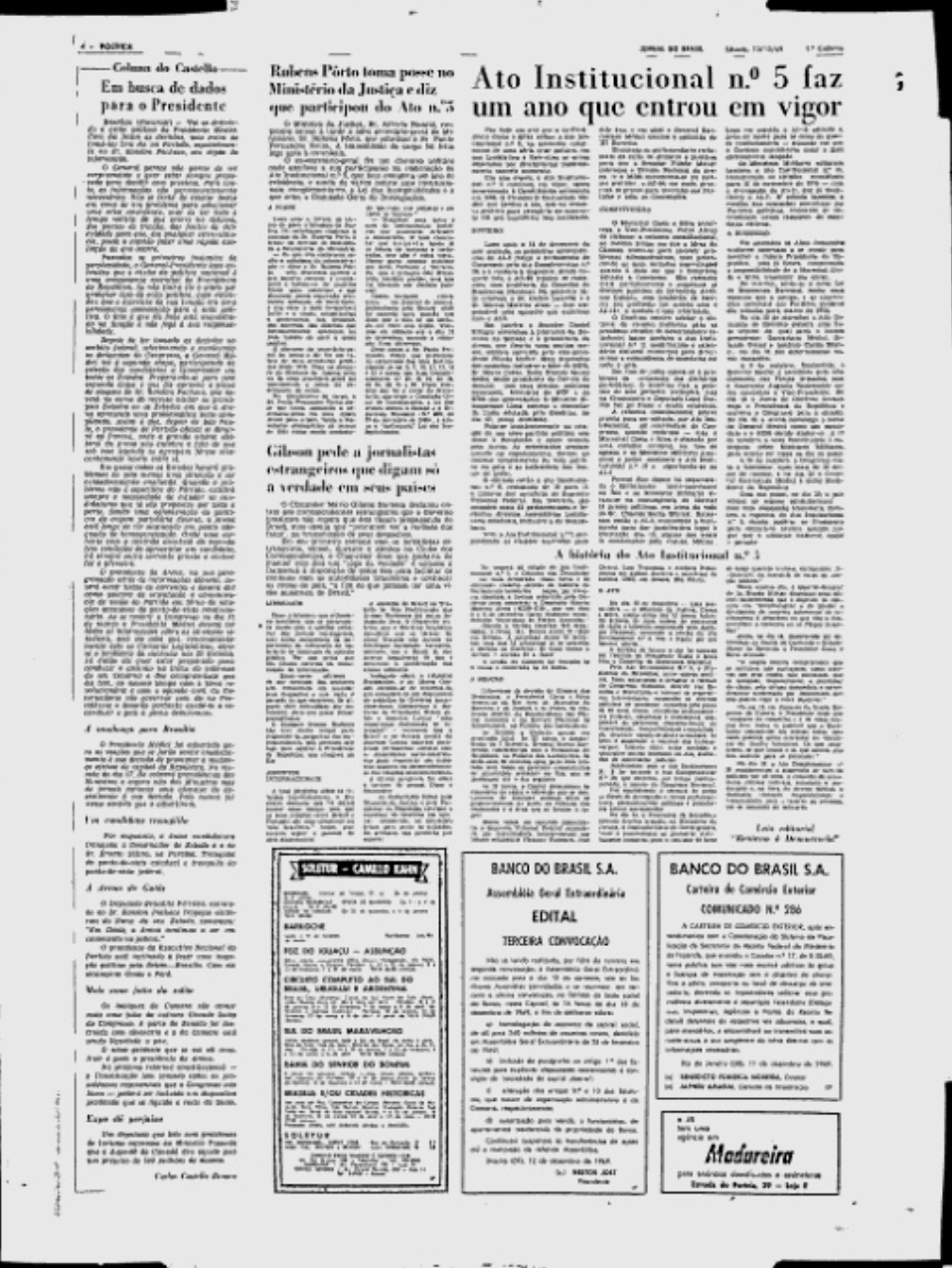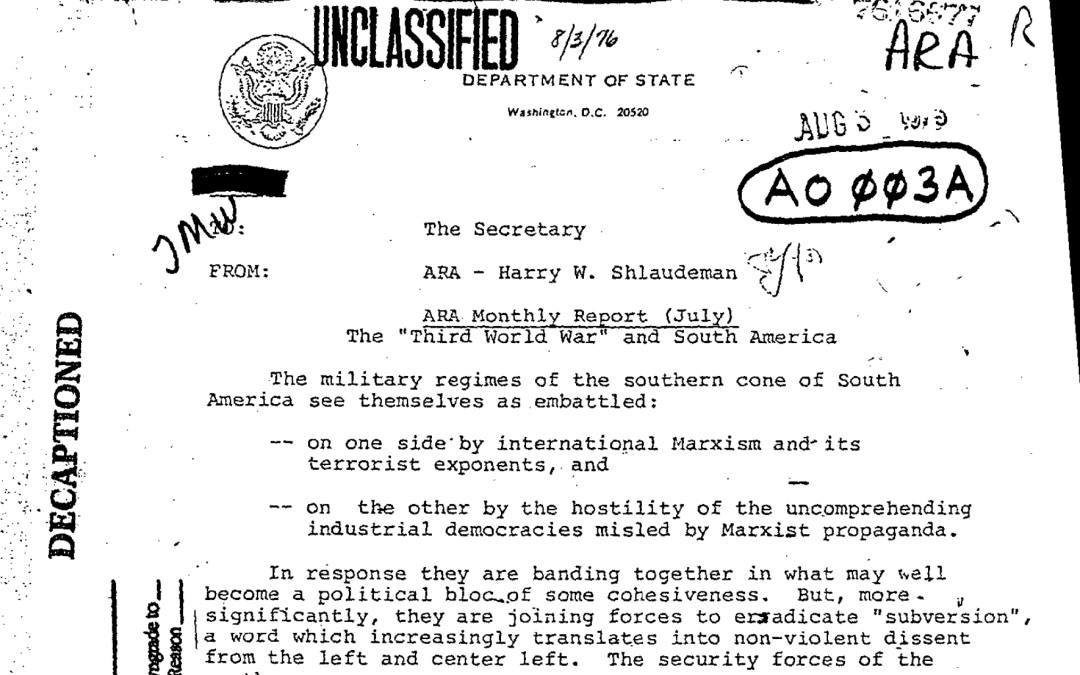The dissolution of the Brazilian military regime is typically referred to as a transition in political structure from an authoritarian to democratic government, aligning with the first civil election of the president [1, 2]. However, due to the drastic extent of change in which the Brazilian political system legislatively became democratic and the populus driven movements that influenced the speed and nature of the transition, Brazil underwent a democratic revolution in the mid 1980s, rather than a mere transition.
After the removal of the liberal President João Goulart by the military coup in 1964, a new “transitionary” administration that eventually evolved into the dictatorship rewrote the federal constitution that restricted the direct involvement of people and increased executive power. In Article 8, section VII, the federal government was granted the power of “censorship of public amusements” and complete control of “telecommunications” and “electric power”, thus restricting public freedom of speech[3]. In regards to voting, the 1967 constitution enabled the president of the regime to select individuals for the positions that would be involved in the electoral college that selected the president in Section II, Article 83: “To appoint and remove the ministers of state, the prefect of the Federal District, and the governors of the territories”[3].
Additionally, the passing of the Fifth Institutional Act (AI-5) in 1968 revoked judicial review and enabled the president to dismiss congress, the one legislative aspect of the 1967 constitution that restricted the executive power of the president [4, 5]. Not only does the constitution and AI-5 highlight the strong opposition to democratic ideals of power concentrated with the people, but it also illustrates the restriction of individual freedom of expression, contrasting the foundational democratic notion of liberty. Furthermore, initial and continuous foreign involvement from the United States, as illustrated by the unclassified Department of State report on South America in 1976, emphasized that the military coup and subsequent dictatorship were the result of global political power dynamics rather than the political will of the Brazilian people [6].
With this strong establishment of anti-democratic rule, there clearly was drastic legislative change with the constitution proposed in 1986 that restricted the executive branch and protected civil liberties that directly addressed the violations of the dictatorship [7]. The language of the document was also more democratic and cited the source of governmental power from the people: “All power emanates from the people, and will be exercised on their behalf” [7]. The contrast between the two documents highlights the clear legislative transformation over a short period of time rather than a gradual transformation.
In addition to the legislative political change of the mid 1980s, there was civilian opposition to the military regime that manifested in social movements calling for a revolution. In 1969, a year after the passing of AI-5, Jornal Do Brasil violated the restrictions on free press and openly criticized the dictatorship for their failed promises to improve the quality of Brazil and its continued violation of democratic rights: “The only definitive way out of the Brazilian political crisis is the democratic way out” [8]. Although it did not come to fruition for another 15 years, the call for democracy by the foremost newspaper of the country emphasized the public disdain with the administration and the popular support to exit the military regime. Furthermore, in 1977, Professor Dr. Goffredo da Silva Telles Júnior from the leading Brazilian Law School read a letter directed to the people of Brazil that elaborated about the legitimacy of laws, constitutions, and power in relation to democracy and the dictatorship:
“We maintain that a State will be more evolved the more the reigning order enshrines and guarantees the right of citizens to be governed by one Sovereign Constitution, drawn up freely by the Representatives of the People, in a Constituent National Assembly; the right not to see anyone ever subjected to provisions of legislative acts of the Executive Branch, contrary to the precepts and spirit of that Constitution” [9]
The call for the fulfillment of legislation on behalf of the people again illustrates the political dissent and mass opposition to the dictatorship and the want for specifically democratic order, later calling the people to demand it: “The legal conscience of Brazil wants one thing only: democracy, now” [9]. The ideas outlined in the letter also contributed to the “Diretas, já” movement of the late 1970s and 1980s which consisted of a series of protests that originated from opposition to the economic policies of the regime, but evolved into a political movement that called for a direct democracy that would allow citizens to vote in presidential elections [10]. The movement, which eventually led to the largest political rally in Brazilian history in 1984 [11], emphasized the extent to which there was mass support for democracy and a willingness to oppose the current politicians that supported the conservative military rule.
Thus, the return to a democratic government was more than just a transition in governmental power. The legislative and social movements that demanded greater liberty and equality for Brazilian citizens was the source that ultimately secured democratic outcomes. Specifically, the extent in which the Brazilian legislation became democratic and the magnitude and demands of citizen oriented movements confirm that Brazil underwent, not a transition, but a democratic revolution that resulted in the collapse of the military regime.


Bibliography
- Adriano Nervo Codato. A political history of the Brazilian transition from military dictatorship to democracy 1. Rev Sociol Polit. 2006;2. http://socialsciences.scielo.org/pdf/s_rsocp/v2nse/scs_a04.pdf
- Mainwaring S. The Transition to Democracy in Brazil. Journal of Interamerican Studies and World Affairs. 1986;28(1):149. doi:https://doi.org/10.2307/165739
- National Congress. Constitution of Brazil; 1967.
- Costa e Silva A. Ato Institutional No. 5.; 1968.
- Institutional Act No. 5 came into force one year ago. Journal Do Brasil. December 13, 1969:4.
- Shlaudman H. The “Third World War” in South America. United States of America Department of State; 1976.
- Brazilian National Constituent Assembly. DRAFT of NEW CONSTITUTION; 1986.
- Retôrno à Democracia. Journal Do Brasil. December 13, 1969:5.
- Silva Telles Jr. G. Carta Aos Brasileiros. Presented at: São Francisco, August 8, 1977.
10.Vidal D. Thousands in Brazil Strike in Defiance of Military Regime. New York Times. May 24, 1978:Section A, 6.
11. Riding A. Direct Vote Backed in Big Brazil Rally. New York Times. May 11, 1984:Section A, Page 10.
This text was past of a final paper for the class SOSC 18500

Adera Craig
Oi! My name is Adera Craig and I am a second-year majoring in Biology and Enviromental and Urban Studies. On campus, I conduct biogeography research on coral reef fish in the Westneat lab and I am involved with the Energy Policy Institue’s undergraduate club where I was able to attend COP27 this year. I am also a member of the Dirt Red Brass Band and a radio show host on Midwave radio. I am studying Portugues because I am interested in ecology research and conservation efforts in Brazil and Mozambique!

